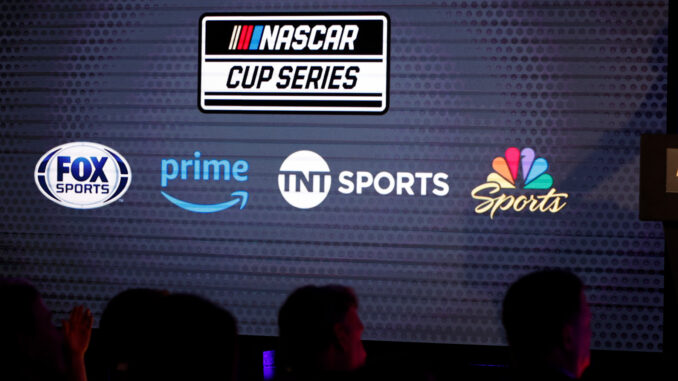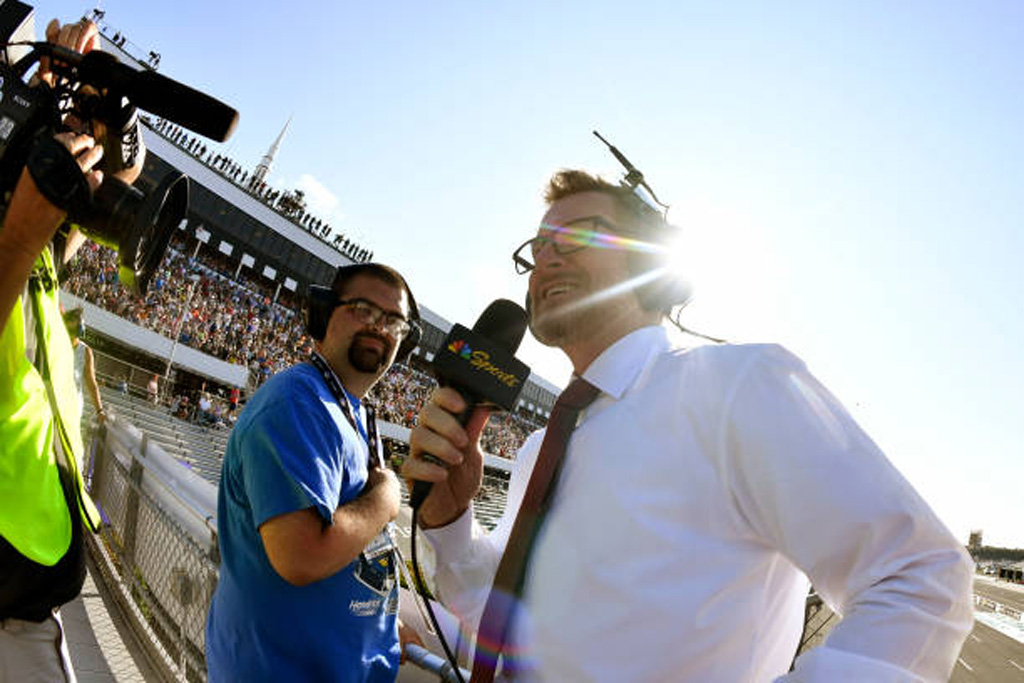
NASCAR’s new media rights deal is confusing by any measure.
The first 14 races will be broadcast on FOX Sports and FS1 along with practice and qualifying for the Clash at the Coliseum, Daytona 500, and All-Star Race at North Wilkesboro. Amazon Prime Video will stream every other practice and qualifying session during that period and will broadcast the next five races. The next five races will air on TNT and stream on HBO Max. NBC, USA, and Peacock will televise the last 14 races of the season, with practice and qualifying televised on truTV and streamed on HBO Max.
If the current two-network deal can make it complicated to figure out which channel any race might be broadcast on, this ups the ante. And it’ll continue this way from 2025 until 2031, NASCAR and its new partners announced last Wednesday.
Compare this to the Xfinity Series broadcast deal. NASCAR announced in July that all Xfinity Series races will move to The CW network next season on television and streaming.
During that announcement, The CW president Dennis Miller called the deal a “win-win” for fans, since all racing content would be available in the same place all year.
“By creating a singular home for NASCAR Xfinity Series races, fans will be able to quickly find their favorite racing entertainment each weekend,” Miller said at the time.
Clearly NASCAR thought so too, since they signed the deal. The Truck Series will also continue to only be aired on FS1, just like this year. So, what’s different with the Cup Series?

It seems like NASCAR’s trying to get everything in one go.
The best data on NASCAR’s TV viewership is almost a decade old now, but the sport has long had a problem with an ageing audience not being replaced by new fans. That’s changed somewhat over the past few years, if at-track attendance is anything to judge by. Michael Jordan and Pitbull both own teams, NASCAR demonstrated its commitment to diversity during the Black Lives Matter Movement, and the sport has expanded its market to downtown Los Angeles and Chicago.
It makes sense, then, to try to meet a younger audience where it’s at – which, for the most part, is streaming – while still trying not to alienate older viewers. Data from this year shows that 31% of Americans in the 18-34 age range use streaming services at least once a day, while just 6% of people over 55 do the same.
The sanctioning body specifically highlighted the importance of streaming while announcing the broadcast deal.
“We are super excited about what 2025 is going to bring to us… which is a combination of obviously broadcast, cable and streaming,” NASCAR President Steve Phelps said. “We want to meet race fans where they are or potential race fans where they are. We think this group does exactly that for us, so we couldn’t be happier to have them on board.”
But to the Xfinity Series, The CW offers both streaming and television thanks to ownership by NexStar. Instead, some Cup Series races and on-track sessions will only be streamed while others will only be televised, forcing viewers to find the channel and pay for a wider variety of services.
NASCAR has to rely on older viewers changing their habits – unlikely – and younger viewers spending additional money – also unlikely, especially considering the massive numbers who have already ditched cable.
Even if NASCAR thinks splitting between television and streaming is the best route, four networks are plenty for anyone, regardless of their age, to juggle all season, especially with the sport in multiple places each weekend.

There are definite benefits for fans though. The biggest one is that big streaming services are interested in NASCAR.
Amazon especially is a multi-billion-dollar company, and its Prime Video is the US’ second-biggest streaming service – probably, although all Prime customers get access, artificially inflating the viewership numbers. Either way, that’s a massive audience, both of NASCAR fans who will get to watch the sport in addition to other content, and potential new viewers who could find the sport.
“In terms of why NASCAR for Amazon,” Prime Video Vice President and Global Head of Sports Jay Marine explained, “what we really look for are premium tier 1 sports that can move the needle for Prime and NASCAR fits that. A sport that has a passionate fan base, a large fan base where the sport is must-see for them. That is extremely valuable.”
Additionally, NASCAR said there was broader interest beyond just the companies they ultimately partnered with, which is another good sign.
“These agreements not only show NASCAR’s importance to the sports and entertainment ecosystem, but also the willingness of some of the world’s largest and most respected media companies to make significant investments in America’s leading motorsport,” NASCAR Senior Vice President, Media and Productions, Brian Herbst said.
Viewers might not be what really matters for this deal, regardless. NASCAR’s current charter model means that TV revenue determines how much NASCAR, its tracks, and especially the race teams earn each year. In October of last year, team owners reportedly met with NASCAR to express their dissatisfaction with what they saw as a lack of progress towards this broadcast deal at that point since that would directly impact their revenue.
Representatives from four teams said the model was “unsustainable,” in the words of Jeff Gordon, with deeper criticisms about how NASCAR was actually dividing the money. Although the deal states that 65% of the TV money goes to the tracks, 25% goes to the teams, and just 10% goes to NASCAR, the committee claimed that NASCAR ended up getting 93% of the money.
Whether that gets fixed, more money coming in is better for everybody. Though the terms of the deal weren’t revealed, The Athletic cites industry insiders who say NASCAR secured a $7.7 billion deal, almost 40% more than the current one, which works out to $1.1 billion a year. Under the current deal, FOX and NBC pay $820 million per year.
NASCAR needs strong viewership numbers to maintain strong revenue streams, and it needs those strong revenue streams to invest in things that continue to draw in viewers. Numbers that suggest increasing profitability for NASCAR, which drivers and team owners confirmed anecdotally to me at Richmond earlier this year, seem to be holding up.
Additionally, the broadcast teams for each network have yet to be announced, but more competition to get the deal and retain their spot could mean that FOX and NBC fix some of the problems that fans have vocally criticized them for throughout the current agreement. That includes technical issues, lack of announcer engagement, poor camera work, and too many commercials.
Plus, NASCAR Productions, which will work in all series, including producing all Xfinity Series content on The CW, will cut the ribbon on a major new investment in facilities and technology on Wednesday.
Though it might take surfing four networks to get it, fans can hope for an increased investment in broadcasting to pay off. Either way, there’ll be more variety for at least seven years to come.